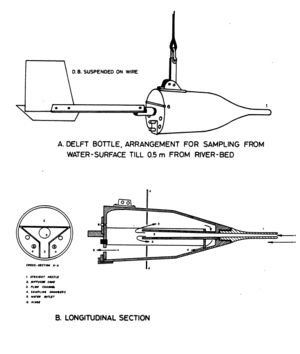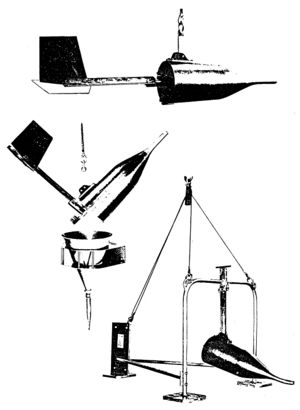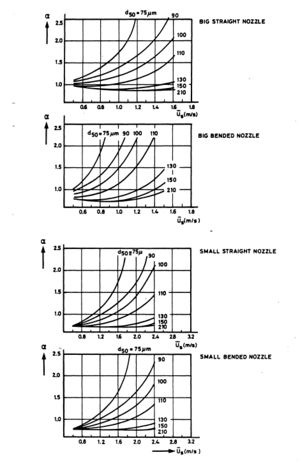Delft Bottle suspended load sampler
This article is a summary of sub-section 5.6.2.5 of the Manual Sediment Transport Measurements in Rivers, Estuaries and Coastal Seas [1]. The Delft Bottle sampler can be used to measure the average sand transport directly.
Contents
Introduction
The Delft Bottle (Figures 1 and 2) is based on the flow-through principle, which means that the water entering the intake nozzle leaves the bottle at the backside. As a result of a strong reduction of the flow velocity due to the bottle geometry, the sand particles larger than about 100 um settle inside the bottle. Using this instrument, the local average sand transport is measured directly. As the overall efficiency of the Delft Bottle is rather low, it is sufficiently accurate to determine only the (immersed) volume of the sand catch on board of the vessel. A small number of the samples can be returned to the laboratory to determine the porosity factor of the sediment sample and the particle size distribution.
The local average sediment transport (in kg/m2/s) is determined as:
[math]S=\alpha\,(1-p)\rho\,_s V_s/(FT)[/math] or [math]S=\alpha\,G_s/(FT)[/math]
in which:
- [math]\alpha\,[/math]= calibration factor according to Figure 3,
- [math]p[/math]= porosity factor,
- [math]\rho\,_s[/math]= density of sediment (2650 kg/m3),
- [math]G_s[/math]= dry mass of sediment (mg),
- [math]V_s[/math]= volume of sediment sample, including pores (m3),
- [math]F[/math]= area of nozzle (m2),
- [math]T[/math]= sampling period (s).
Calibration
Sampling errors are introduced by:
- incorrect intake velocity compared with local flow velocity; the hydraulic coefficient (ratio of intake velocity and local flow velocity) varies from 1 to 1.5 (Dijkman, 1978[2], 1981[3]),
- inefficiency of the sampler to collect relatively fine sediment material (particles finer than 100 um),
- additional sampling during raising and lowering of the instrument,
- sediment losses during removal of the sand catch from the DB.
Usually, only the first two errors are corrected using a calibration factor a according to Figure 3, which is based on extensive laboratory measurements (Dijkman, 1981[3]). The k-factor varies from 0.7 to 2.5 depending on the nozzle type, particle size and local flow velocity. The sampling error due to the collection of sediment particles during lowering and raising of the instrument can be reduced by using a relatively large sampling period (15 minutes). Otherwise, an additional calibration factor is necessary (Dijkman, 1981[3]). The minimum sampling time is about 5 minutes to obtain a statistically reliable result. An additional advantage of a long sampling period is the collection of a large sediment catch enabling an accurate determination of particle size (by sieving).
Field measurements show sampling errors up to 50% for individual samples, even after the application of the calibration factor. Considering these large errors, the Delft Bottle can only be used to obtain a rough estimate of the local sand transport. Therefore, it is sufficiently accurate to determine only the volumetric quantity of the sand sample (in situ). In that case the laboratory analysis is rather limited, which is an advantage of the Delft Bottle method. The Delft Bottle should not be used in tidal flow conditions with relatively small sediment concentrations because of the long sampling period which is required to obtain a measurable sediment catch.
See also
Summaries of the manual
- Manual Sediment Transport Measurements in Rivers, Estuaries and Coastal Seas
- Chapter 1: Introduction, problems and approaches in sediment transport measurements
- Chapter 2: Definitions, processes and models in morphology
- Chapter 3: Principles, statistics and errors of measuring sediment transport
- Chapter 4: Computation of sediment transport and presentation of results
- Chapter 5: Measuring instruments for sediment transport
- Chapter 6: Measuring instruments for particle size and fall velocity
- Chapter 7: Measuring instruments for bed material sampling
- Chapter 8: Laboratory and in situ analysis of samples
- Chapter 9: In situ measurement of wet bulk density
- Chapter 10: Instruments for bed level detection
- Chapter 11: Argus video
- Chapter 12: Measuring instruments for fluid velocity, pressure and wave height
Other internal links
- Bottle and trap samplers
- USP-61 suspended load sampler
- USP-61 suspended load sampler
- Collabsible-Bag depth integrating sampler
- Sand transport
Further reading
Dijkman, J. and Milisic, V., 1982. Investigations on Suspended Sediment Samplers. Delft Hydraulics Laboratory and Jaroslav Cerni Institute, Report S410, The Netherlands
References
- ↑ Rijn, L. C. van (1986). Manual sediment transport measurements. Delft, The Netherlands: Delft Hydraulics Laboratory
- ↑ Dijkman, J., 1978. Some Characteristics of the USP-61 and Delft Bottle. Delft University of Technology, Dep. of Civ.Eng., Int. Report No. 5-78, The Netherlands
- ↑ 3.0 3.1 3.2 Dijkman, J., 1981. Investigation of Characteristic Parameters of Delft Bottle. Delft Hydraulics Laboratory, Report S362, The Netherlands
Please note that others may also have edited the contents of this article.
|
Please note that others may also have edited the contents of this article.
|


